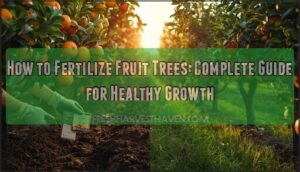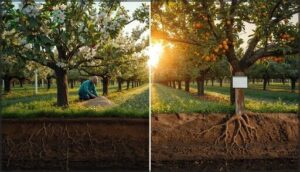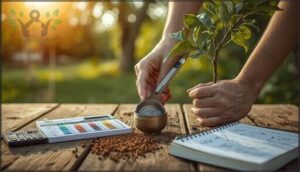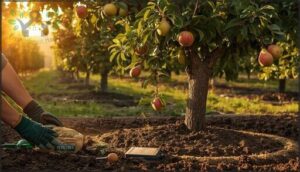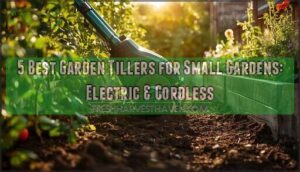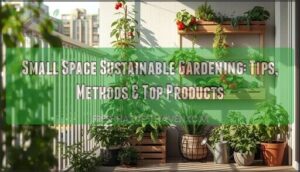This site is supported by our readers. We may earn a commission, at no cost to you, if you purchase through links.
Your fruit trees might look healthy, but hidden nutrient deficiencies can quietly slash your harvest by half or more. Most orchards face boron shortages that weaken fruit development, while soil low in organic matter starves roots of the nitrogen they need to thrive.
A single season of proper fertilization can reverse these losses, boosting yields anywhere from 20 to 70 percent depending on your soil’s starting point.
The difference between a tree that barely produces and one that rewards you with abundant, quality fruit often comes down to understanding what nutrients your soil lacks and how to deliver them at the right time.
Testing your soil reveals exactly what your trees are missing, then choosing the right fertilizer and applying it correctly turns those insights into tangible results.
Table Of Contents
- Key Takeaways
- Why Fertilizing Fruit Trees is Essential
- When and How Often to Fertilize Fruit Trees
- Choosing The Right Fertilizer for Fruit Trees
- Step-by-Step Guide to Fertilizing Fruit Trees
- Advanced Tips for Healthy and Productive Trees
- Frequently Asked Questions (FAQs)
- When should I fertilize my Trees?
- When is the best time to fertilize fruit trees?
- Should you fertilize fruit trees in the winter?
- How do you fertilize fruit trees for a big harvest?
- In what month should you fertilize your fruit trees?
- How do you apply 10-10-10 fertilizer to fruit trees?
- What does Epsom salt do for fruit trees?
- How often should you fertilize a fruit tree?
- Why is fertilizing a fruit tree important?
- What fertilizer should a fruit tree use?
- Conclusion
Key Takeaways
- Hidden nutrient deficiencies—especially boron and nitrogen—can slash fruit yields by half, but soil testing reveals exactly what your trees need before visible symptoms appear.
- Fertilizing in early spring before bud break delivers the best results, while late summer or fall applications risk frost damage by promoting tender growth that won’t survive winter.
- Proper fertilization can boost yields by 20 to 70 percent depending on soil conditions, with young trees needing less nitrogen to prevent excessive growth and mature trees requiring balanced formulas.
- Organic fertilizers build long-term soil health and microbial activity, while synthetic options provide rapid nutrient correction—combining both approaches often delivers the strongest results.
Why Fertilizing Fruit Trees is Essential
Fertilizing your fruit trees isn’t just a nice extra step, it’s the foundation for trees that actually produce the kind of harvest you’re hoping for. Without the right nutrients at the right times, even healthy-looking trees can struggle with small fruit, poor yields, and vulnerability to pests and diseases.
Let’s look at three key reasons why proper fertilization makes all the difference in your orchard.
Boosting Fruit Yield and Quality
When you fertilize your fruit trees correctly, you can boost yields considerably—sometimes by 20 to 70 percent depending on nutrient optimization and fertilizer type. Chemical fertilizers often rapidly boost fruit production, while organic options like compost improve soil health and fruit quality over time.
Proper fertilization can boost fruit tree yields by 20 to 70 percent, with chemical fertilizers acting fast and organic options building long-term soil health
However, there’s a trade-off: pushing for maximum yield can sometimes reduce vitamin content and flavor in your harvest. For example, proper fertilization can influence the yield of white pulped dragon fruit.
Preventing Nutrient Deficiencies
Beyond maximizing yield, you need to watch for nutrient deficiencies that can quietly undermine your orchard. Surveys in Montana revealed that 84% of soils lacked adequate boron, while nitrogen shortfalls remain widespread. Without preventive measures and soil testing, your trees may suffer reduced fruit size and poor growth before visible symptoms appear.
Consider these common deficiency risks:
- Boron deficiency affects most orchards without supplementation
- Nitrogen shortfalls occur when organic matter drops below 3%
- Phosphorus levels below 15 ppm stunt fruit development
- Tissue analysis catches problems before leaves show damage
Regional guidelines now emphasize combining soil testing with foliar analysis to catch imbalances early. Don’t wait for yellowing leaves or stunted fruit—proactive fertilizing keeps your trees productive year after year. Soil analysis is essential for determining nutrient levels and pH.
Enhancing Tree Health and Resistance
Strong nutrient regimes do more than prevent deficiencies—they build resilient trees. Balanced fertilization strengthens disease resistance; for example, potassium applications lower scab lesions in apples.
When you apply foliar nutrition during stress periods, you reduce leaf water deficit and improve drought tolerance. Healthy soil biota, nurtured through organic matter, suppress replant disease and boost overall tree health through improved stress acclimation.
When and How Often to Fertilize Fruit Trees
Timing your fertilizer applications correctly can make the difference between a thriving orchard and a disappointing harvest. You need to understand when your trees are hungry, when they’re resting, and when feeding them could actually cause harm.
Let’s break down the seasonal timing, how your tree’s age and type affect the schedule, and those critical moments when you should keep the fertilizer bag closed.
Best Time of Year for Fertilizing
Timing your fruit tree’s seasonal fertilizer timing can make or break your harvest. Early spring—right around bud break—is your sweet spot, when roots eagerly pull nutrients as sap starts flowing. Here’s what guides your schedule:
- Early spring applications (April to mid-May) fuel that first growth surge
- Split applications through mid-season match nutrient supply to demand
- Avoiding fall fertilization prevents tender shoots that won’t survive winter’s bite
- Climate adjustments matter: warmer regions can feed earlier, even late winter
Late summer fertilization risks pushing growth that won’t harden before dormancy arrives.
How Tree Age and Type Affect Timing
As your tree matures, its appetite shifts. Young trees under three years need nitrogen-focused feeding to build structure, while established bearing trees thrive on balanced or potassium-rich formulas.
Species timing needs vary too—apples often benefit from earlier spring applications than peaches, and citrus prefers more potassium throughout the season.
Calculate fertilizer amounts using age: 0.10 pounds of nitrogen per year, maxing out at one pound for mature specimens.
When Not to Fertilize
While proper feeding fuels growth, there are times when it can backfire. Avoid these five critical periods:
- Dormant Season – Nutrient uptake drops by up to 85%, wasting fertilizer and risking groundwater pollution.
- Late Summer – Promotes tender growth vulnerable to frost damage.
- Drought Conditions – Can burn roots and reduce yields by 80%.
- Flowering Period – Over-fertilization may cause up to one-third flower loss.
- Low-Nutrient Trees (figs, olives) – Already adapted; excess feeding reduces fruit production.
Choosing The Right Fertilizer for Fruit Trees
Picking the right fertilizer isn’t about grabbing the first bag off the shelf—it’s about matching what you buy to what your trees actually need. Your soil’s unique chemistry, the type of fruit you’re growing, and whether you prefer organic or synthetic all play a role in that decision.
Let’s break down the key factors you’ll want to think about before you make your choice.
Understanding NPK Ratios and Soil Needs
You can’t feed your trees blindly and expect great results. The NPK ratio—nitrogen, phosphorus, and potassium—tells you what your fertilizer delivers, with balanced options like 10-10-10 working well for most fruit trees.
Soil testing reveals nutrient deficiencies and pH levels, guiding smarter choices that improve fruit tree nutrition and soil health. Specific fertilization can boost your fertilizer ROI by up to 27% while preventing common micronutrient needs from going unmet.
Organic Vs. Synthetic Fertilizer Options
Choosing the right fertilizer means weighing organic against synthetic options, each with distinct trade-offs for nutrient release, soil health, and environmental impact. Organic fertilizers improve microbial activity and carbon sequestration, releasing nutrients slowly over months. Synthetic fertilizers deliver rapid results but can acidify soil and increase runoff risks.
Consider these differences:
- Organic options boost fruit quality and reduce chemical residues
- Synthetics provide immediate nutrient availability for quick corrections
- Organic fertilizers improve long-term soil structure and water retention
- Controlled-release synthetics improve nutrient efficiency by 20-30%
- Safety implications favor organic fertilizers for health-conscious growers
Fruit-Specific Fertilizer Recommendations
Different fruit trees have distinct nutrient needs you’ll want to match carefully. Apple N requirements generally fall between 50–80 kg per hectare annually, while citrus fertilizer timing spreads 1.0 pound of nitrogen across late winter through early summer.
Stone fruit NPK shifts toward potassium during fruit development, berry shrub pH stays between 4.5–5.5 with acidic formulations, and grapevine fertigation delivers weekly potassium pulses after budbreak for best canopy growth.
Step-by-Step Guide to Fertilizing Fruit Trees
Once you’ve selected the right fertilizer, the next step is learning how to apply it correctly. The process isn’t complicated, but getting the amounts and methods right makes all the difference for your trees.
Here’s what you need to know to fertilize safely and effectively.
Calculating Fertilizer Amounts
Getting the fertilizer amounts right matters more than you’d think. For young fruit trees, apply 0.05 pounds of nitrogen per year of tree age, maxing out at 0.75 pounds for mature trees. Alternatively, use trunk diameter: multiply 0.1 pounds nitrogen by each inch of diameter.
Soil testing helps you fine-tune NPK ratios and avoid overfertilization risks that weaken trees and reduce yields.
Applying Granular, Liquid, and Topdressing Methods
Once you know your granular application rates, spread the fertilizer evenly from one foot outside the trunk to the drip line—that’s where active roots absorb nutrients best. Liquid fertigation scheduling works well through drip systems, delivering diluted solutions weekly during the growing season.
Compost topdressing methods involve layering two to three inches of finished compost under the canopy each spring. Integrating fertilizer types—combining granular, liquid, and organic matter—gives you both quick results and long-term soil health.
Fertilizer Application Safety Tips
Fertilizer application demands respect for both your trees and your safety. Always wear protective gear—latex or nitrile gloves, long sleeves, closed-toe shoes, and a dust mask prevent skin burns and respiratory irritation from fertilizer salts.
Follow these fertilizer safety guidelines:
- Store products in original containers, away from food and flames
- Apply on calm days to avoid inhaling dust or spray
- Keep children and pets away until fertilizers absorb completely
Safe storage and proper application timing protect against over-fertilization risks and environmental impact, preventing nutrient burns while keeping your orchard healthy.
Advanced Tips for Healthy and Productive Trees
Once you’ve covered the basics of feeding your fruit trees, a few sophisticated strategies can make a real difference in long-term health and harvest quality.
These techniques go beyond simple application timing, helping you fine-tune your approach based on tree age, soil conditions, and common pitfalls that even experienced growers encounter.
Let’s look at how to adjust your fertilization practices for stronger, more productive trees year after year.
Adjusting Fertilization for Young or Established Trees
When your tree is young, you’ll apply less nitrogen—usually 0.05 to 0.10 kilograms per year of age—to avoid excessive growth vigor that delays fruiting. As your tree matures, nitrogen application rates cap around 0.45 to 0.68 kilograms.
Split fertilizer doses help match nutrient uptake to root development and tree growth stages, while adjusting fertilizer application lessens environmental risk and fosters healthier root systems.
Monitoring Soil and Tree Health
Once you’ve fine-tuned your fertilizer amounts, soil testing and analysis every three years reveal pH, organic matter, and nutrient deficiencies like potassium or phosphorus. Leaf analysis detects boron or sulfur shortages that soil tests might miss.
Visual inspection helps you spot chlorosis or wilting early, while sensor technology tracks moisture and stress before symptoms appear.
Monitoring soil health and tree health together keeps your orchard productive year after year.
Avoiding Common Fertilization Mistakes
Because common mistakes in fertilization can derail your orchard’s productivity, watch for nitrogen overapplication—excess nitrogen suppresses fruit yield while polluting groundwater. Avoid incorrect fertilizer ratios that promote leaves over fruit, and don’t fertilize after July; wrong timing invites frost damage.
Ignoring soil tests leads to nutrient deficiencies or toxicity. Overfertilization wastes money and harms the environment, while underfertilization starves your trees, so follow fertilizer safety guidelines closely.
Integrating Organic Matter for Long-Term Benefits
Building your soil’s vitality through organic matter delivers benefits that compound year after year. Compost and mulch applications increase soil carbon sequestration while boosting water use efficiency by up to 50% in field studies, strengthening your orchard’s resilience against drought.
- Enhanced nutrient availability: Organic fertilizers release nitrogen gradually, reducing leaching and supporting steady tree growth
- Improved soil biological activity: Microbial populations thrive in organic matter, cycling nutrients and protecting roots from disease
- Enhanced soil structure resilience: Repeated organic amendments increase soil health, lowering bulk density and improving root penetration for sustained productivity
Frequently Asked Questions (FAQs)
When should I fertilize my Trees?
Think of timing like catching the morning sun—fertilize your fruit trees in early spring, just before bud break, when soil temperature reaches 50°F and growth stage transitions from dormancy to active development.
When is the best time to fertilize fruit trees?
The best time to fertilize fruit trees is early spring, between April and mid-May, just before bud break.
This timing aligns nutrient availability with active growth, ensuring peak uptake as roots and shoots awaken.
Should you fertilize fruit trees in the winter?
Winter fertilization of fruit trees is generally not recommended. Trees enter dormancy when soil temperatures drop below 40°F, halting nutrient uptake.
Winter applications risk leaching, groundwater contamination, and nutrient loss.
Wait until early spring before bud break for best results.
How do you fertilize fruit trees for a big harvest?
Like a well-tuned engine, your fruit trees need balanced fuel. Improve nitrogen and potassium doses for 35% yield increases.
Monitor soil pH and micronutrient needs through testing. Apply fertilizer at your drip line, preventing runoff.
Time applications with growth phases for maximum root health and fruit production.
In what month should you fertilize your fruit trees?
Early spring, between March and May, is your best time for fertilizing fruit trees. Apply fertilizer before bud break to get the most from nutrient uptake.
Avoid late summer and fall applications, which increase frost damage risk and disrupt dormancy preparation.
How do you apply 10-10-10 fertilizer to fruit trees?
Think of your tree’s drip line as its feeding zone. Spread 10-10-10 granular fertilizer evenly within this area, starting a foot from the trunk.
Work it into the top 2-4 inches of soil and water thoroughly to activate nutrients.
What does Epsom salt do for fruit trees?
Epsom salt supplies magnesium sulfate, an essential micronutrient that strengthens chlorophyll production and photosynthesis. It corrects magnesium deficiency, enhancing fruit quality, increasing yields, and boosting pest resistance.
Apply two tablespoons per nine square feet, three to four times annually, following soil testing.
How often should you fertilize a fruit tree?
Most fruit trees need fertilizing once yearly in spring, though regional conditions matter. Sandy soils in South Florida require applications every three months, while mature trees in fertile soils may need less.
Soil testing and monitoring growth signs help you determine your tree’s specific needs.
Why is fertilizing a fruit tree important?
Proper fertilization delivers essential nutrients that boost yield improvement, improve fruit quality, and strengthen disease resistance. Well-nourished trees achieve better growth promotion and tree longevity, while preventing deficiencies that reduce fruit set and size.
This investment directly benefits your fruit tree health and productivity.
What fertilizer should a fruit tree use?
Your tree’s needs depend on soil testing results and species. A balanced 10-10-10 works for most fruit trees, though citrus prefers 15-10-10, and peaches benefit from 10-15-
Organic options like compost build soil health long-term, while synthetic fertilizers deliver quick nutrient fixes.
Conclusion
The healthiest fruit trees aren’t always the most productive ones—without proper nutrition, vigorous growth means little at harvest time. Learning how to fertilize fruit trees transforms guesswork into strategy, turning soil tests and targeted applications into measurable gains.
Your trees will reward precise care with stronger limbs, disease resistance, and yields that finally match their potential. The work you put into understanding their needs today shapes every harvest for years ahead.
- https://soiltesting.cahnr.uconn.edu/suggested-fertilizer-practices-for-tree-fruits/
- https://treefruit.wsu.edu/orchard-management/soils-nutrition/general_soils_101/
- https://pmc.ncbi.nlm.nih.gov/articles/PMC9141052/
- https://journals.ashs.org/view/journals/hortsci/60/5/article-p657.xml
- https://pubs.nmsu.edu/_h/H319/index.html

